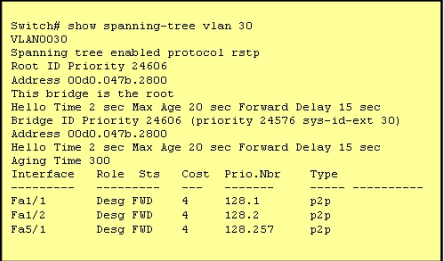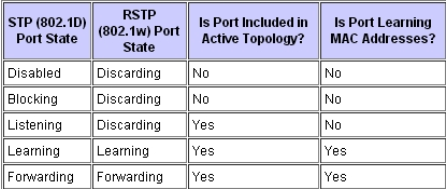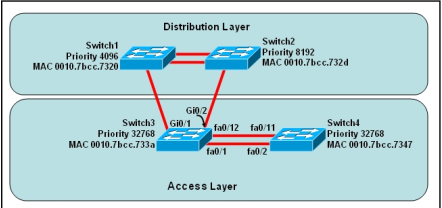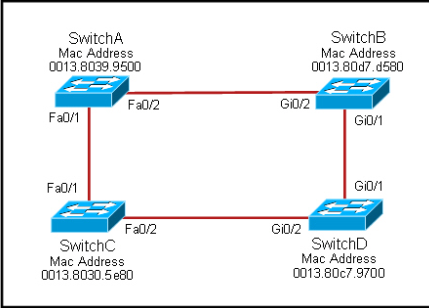[2017-Mar-NEW]Realistic Cisco CCNA ICND2 200-105 Dumps DOC + PDF in Kinds of Cisco IT Exam Q&As
The country in which a person lives don’t matter, individuals living in any corner of the world can get the Cisco 200-105 Practice Exam as there is only a requirement of having an internet connection through which a person can download 200-125 Test Questions. So, there is no need to take tension if the person is not the resident of USA or Canada.Pass4itsure offer to download the CCNA Cisco Certified Network Associate CCNA (v3.0) 200-105 dumps while the others have different processes through which they provide the Cisco 200-125 Study Material to those who need it for the perfect performance and to get the CCNA Routing and Switching certification with good marks.
Exam Code: 200-105
Exam Name: Interconnecting Cisco Networking Devices Part 2 (ICND2 v3.0)
Updated: Mar 09, 2017
Q&As: 204
Exam Number:200-105 ICND2
Associated Certifications:CCNA Routing & Switching
Duration:90 Minutes (45-55 questions)
Available Languages:English, Japanese
Register:Pearson VUE
Exam Policies:Read current policies and requirements
Exam Tutorial:Review type of exam questions
Exam Information:http://www.pass4itsure.com/200-105.html
Pass4itsure are dedicated to our vocation and do not compromise with our standards at all. Our main purpose is the care of its top specifications and obviously your achievements. We endow experts with 100% qualified and effective Cisco 200-105 CCNA Routing & Switching exam classes which perform an important and key part to clear Cisco 200-105 exam certification 100% efficiently and start new opinions of achievements.
Recommended Experience
- Completion of Cisco CCENT/CCNA ICND1 100-105 or equivalent knowledge
Recommended Equipment
- GNS3 emulated environment
- Cisco 2600 series router
- Cisco 2950 or 3550 (ideal) switch
Related Certifications
- CCNA Routing and Switching
Related Job Functions
- Network technician
- Network engineer
We guarantee to make you 200-105 qualified by delivering best study materials and components. We offer the applicants with personalized and constantly improved Cisco 200-105 dumps study materials.
2017 Cisco 200-105 dumps (#01-07) Pass4itsure:
200-105 dumps Question No : 1 – (Topic 1) Refer to the exhibit.

The output that is shown is generated at a switch. Which three statements are true?
(Choose three.)
A. All ports will be in a state of discarding, learning, or forwarding.
B. Thirty VLANs have been configured on this switch.
C. The bridge priority is lower than the default value for spanning tree.
D. All interfaces that are shown are on shared media.
E. All designated ports are in a forwarding state.
F. This switch must be the root bridge for all VLANs on this switch.
Answer: A,C,E
Explanation:
From the output, we see that all ports are in Designated role (forwarding state) -> A and E
are correct.
The command “show spanning-tree vlan 30 only shows us information about VLAN 30. We
don’t know how many VLAN exists in this switch -> B is not correct.
The bridge priority of this switch is 24606 which is lower than the default value bridge
priority 32768 -> C is correct.
All three interfaces on this switch have the connection type “p2p”, which means Point-to
point environment – not a shared media -> D is not correct.
The only thing we can specify is this switch is the root bridge for VLAN 3o but we can not
guarantee it is also the root bridge for other VLANs -> F is not correct.
200-105 dumps Question No : 2 – (Topic 1) Which port state is introduced by Rapid-PVST?
A. learning
B. listening
C. discarding
D. forwarding
Answer: C
Explanation:
Spanning Tree from PVST+ to Rapid-PVST Migration Configuration Example
PVST+ is based on IEEE802.1D Spanning Tree Protocol (STP). But PVST+ has only 3 port
states (discarding, learning and forwarding) while STP has 5 port states (blocking, listening,
learning, forwarding and disabled). So discarding is a new port state in PVST+.

Background Information
802.1D Spanning Tree Protocol (STP) has a drawback of slow convergence. Cisco
Catalyst switches support three types of STPs, which are PVST+, rapid-PVST+ and MST.
PVST+ is based on IEEE802.1D standard and includes Cisco proprietary extensions such
as BackboneFast, UplinkFast, and PortFast. Rapid-PVST+ is based on IEEE 802.1w
standard and has a faster convergence than 802.1D. RSTP (IEEE 802.1w) natively
includes most of the Cisco proprietary enhancements to the 802.1D Spanning Tree, such
as BackboneFast and UplinkFast. Rapid-PVST+ has these unique features:
Uses Bridge Protocol Data Unit (BPDU) version 2 which is backward compatible with the
802.1D STP, which uses BPDU version 0.
All the switches generate BPDUs and send out on all the ports every 2 seconds, whereas
in 802.1D STP only the root bridge sends the configuration BPDUs.
Port Roles—Root port, designated port, alternate port and backup port.
Port States—Discarding, Learning, and Forwarding.
Port Types—Edge Port (PortFast), Point-to-Point and Shared port.
Rapid-PVST uses RSTP to provide faster convergence. When any RSTP port receives
legacy 802.1D BPDU, it falls back to legacy STP and the inherent fast convergence
benefits of 802.1w are lost when it interacts with legacy bridges.
200-105 dumps Question No : 3 – (Topic 1) refer to the exhibit.

At the end of an RSTP election process, which access layer switch port will assume the
discarding role?
A. Switch3, port fa0/1
B. Switch3, port fa0/12
C. Switch4, port fa0/11
D. Switch4, port fa0/2
E. Switch3, port Gi0/1
F. Switch3, port Gi0/2
Answer: C
Explanation:
In this question, we only care about the Access Layer switches (Switch3 & 4). Switch 3 has
a lower bridge ID than Switch 4 (because the MAC of Switch3 is smaller than that of
Switch4) so both ports of Switch3 will be in forwarding state. The alternative port will surely
belong to Switch4.
Switch4 will need to block one of its ports to avoid a bridging loop between the two
switches. But how does Switch4 select its blocked port? Well, the answer is based on the
BPDUs it receives from Switch3. A BPDU is superior than another if it has:
1. A lower Root Bridge ID2. A lower path cost to the Root3. A lower Sending Bridge ID4. A
lower Sending Port ID
These four parameters are examined in order. In this specific case, all the BPDUs sent by
Switch3 have the same Root Bridge ID, the same path cost to the Root and the same
Sending Bridge ID. The only parameter left to select the best one is the Sending Port ID
(Port ID = port priority + port index). In this case the port priorities are equal because they
use the default value, so Switch4 will compare port index values, which are unique to each
port on the switch, and because Fa0/12 is inferior to Fa0/1, Switch4 will select the port
connected with Fa0/1 (of Switch3) as its root port and block the other port -> Port fa0/11 of
Switch4 will be blocked (discarding role)
200-105 dumps Question No : 4 – (Topic 1) At which layer of the OSI model is RSTP used to prevent loops?
A. physical
B. data link
C. network
D. transport
Answer: B
Explanation: RSTP and STP operate on switches and are based on the exchange of
Bridge Protocol Data Units (BPDUs) between switches. One of the most important fields in
BPDUs is the Bridge Priority in which the MAC address is used to elect the Root Bridge ,
RSTP operates at Layer 2.
200-105 dumps Question No : 5 – (Topic 1) What is one benefit of PVST+?
A. PVST+ supports Layer 3 load balancing without loops.
B. PVST+ reduces the CPU cycles for all the switches in the network.
C. PVST+ allows the root switch location to be optimized per VLAN.
D. PVST+ automatically selects the root bridge location, to provide optimized bandwidth
usage.
Answer: C
Explanation:
Per VLAN Spanning Tree (PVST)
Introduction
http://www.cisco.com/en/US/tech/tk389/tk621/tk846/tsd_technology_support_sub
protocol_home.html
Per VLAN Spanning Tree (PVST) maintains a spanning tree instance for each VLAN
configured in the network. This means a switch can be the root bridge of a VLAN while
another switch can be the root bridge of other VLANs in a common topology. For example,
Switch 1 can be the root bridge for Voice data while Switch 2 can be the root bridge for
Video data. If designed correctly, it can optimize the network traffic
200-105 dumps Question No : 6 – (Topic 1)
Refer to the exhibit

Each of these four switches has been configured with a hostname, as well as being
configured to run RSTP. No other configuration changes have been made. Which three of
these show the correct RSTP port roles for the indicated switches and interfaces? (Choose
three.)
A. SwitchA, Fa0/2, designated
B. SwitchA, Fa0/1, root
C. SwitchB, Gi0/2, root
D. SwitchB, Gi0/1, designated
E. SwitchC, Fa0/2, root
F. SwitchD, Gi0/2, root
Answer: A,B,F
Explanation:
The question says “no other configuration changes have been made” so we can
understand these switches have the same bridge priority. SwitchC has lowest MAC
address so, it will become root bridge and 2 of its ports (Fa0/1 & Fa0/2) will be designated
ports (DP). Because SwitchC is the root bridge the 2 ports nearest SwitchC on SwitchA
(Fa0/1) and SwitchD (Gi0/2) will be root ports (RP) -> B and F are correct.
SwitchB must have a root port so which port will it choose? To answer this question we
need to know about STP cost and port cost. In general, “cost” is calculated based on bandwidth of the link. The higher the bandwidth on a link, the lower the value of its cost. Below are the cost values you should memorize:
Link speed Cost SwitchB will choose the interface with lower cost to the root bridge as the
root port so we must calculate the cost on interface Gi0/1 & Gi0/2 of SwitchB to the root
bridge. This can be calculated from the “cost to the root bridge” of each switch because a
switch always advertises its cost to the root bridge in its BPDU. The receiving switch will
add its local port cost value to the cost in the BPDU.
SwitchC advertises its cost to the root bridge with a value of 0. Switch D adds 4 (the cost
value of 1Gbps link) and advertises this value (4) to SwitchB. SwitchB adds another 4 and
learns that it can reach SwitchC via Gi0/1 port with a total cost of 8. The same process
happens for SwitchA and SwitchB learns that it can reach SwitchC via Gi0/2 with a total
cost of 23 -> Switch B chooses Gi0/1 as its root port.
Now our last task is to identify the port roles of the ports between SwitchA & SwitchB. It is
rather easy as the MAC address of SwitchA is lower than that of SwitchB so Fa0/2 of
SwitchA will be designated port while Gi0/2 of SwitchB will be alternative port.
200-105 dumps Question No : 7 – (Topic 1) Which three of these statements regarding 802.1Q trunking are correct? (Choose three.)
A. 802.1Q native VLAN frames are untagged by default.
B. 802.1Q trunking ports can also be secure ports.
C. 802.1Q trunks can use 10 Mb/s Ethernet interfaces.
D. 802.1Q trunks require full-duplex, point-to-point connectivity.
E. 802.1Q trunks should have native VLANs that are the same at both ends.
Answer: A,C,E
Explanation:
CCNA Self-Study (ICND Exam): Extending Switched Networks with Virtual LANs
Cisco certification 200-105 Test Answers exams has become more and more popular in the fiercely competitive IT industry. Although more and more people sign up to attend this examination of, the official did not reduce its difficulty and it is still difficult to pass the exam. After all, this is an authoritative test to inspect the computer professional knowledge and information technology ability. In order to pass the Cisco certification 200-105 Test Answers, generally, many people need to spend a lot of time and effort to review http://www.pass4itsure.com/200-105.html
Official Site:http://www.cisco.com/c/en/us/training-events/training-certifications/exams/current-list/200-105-icnd2.html
![[2017-November-NEW] Most Accurate Valid SPROUTE 642–883 Dumps Study Guide PDF With New Discount [Video]](https://www.collection4pdf.com/wp-content/themes/ribbon-lite/images/nothumb-related.png)